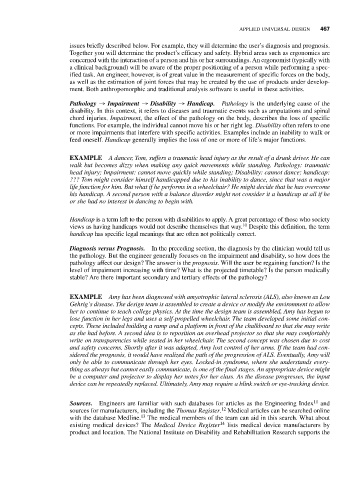Page 489 - Biomedical Engineering and Design Handbook Volume 2, Applications
P. 489
APPLIED UNIVERSAL DESIGN 467
issues briefly described below. For example, they will determine the user’s diagnosis and prognosis.
Together you will determine the product’s efficacy and safety. Hybrid areas such as ergonomics are
concerned with the interaction of a person and his or her surroundings. An ergonomist (typically with
a clinical background) will be aware of the proper positioning of a person while performing a spec-
ified task. An engineer, however, is of great value in the measurement of specific forces on the body,
as well as the estimation of joint forces that may be created by the use of products under develop-
ment. Both anthropomorphic and traditional analysis software is useful in these activities.
Pathology → Impairment → Disability → Handicap. Pathology is the underlying cause of the
disability. In this context, it refers to diseases and traumatic events such as amputations and spinal
chord injuries. Impairment, the effect of the pathology on the body, describes the loss of specific
functions. For example, the individual cannot move his or her right leg. Disability often refers to one
or more impairments that interfere with specific activities. Examples include an inability to walk or
feed oneself. Handicap generally implies the loss of one or more of life’s major functions.
EXAMPLE A dancer, Tom, suffers a traumatic head injury as the result of a drunk driver. He can
walk but becomes dizzy when making any quick movements while standing. Pathology: traumatic
head injury; Impairment: cannot move quickly while standing; Disability: cannot dance; handicap:
??? Tom might consider himself handicapped due to his inability to dance, since that was a major
life function for him. But what if he performs in a wheelchair? He might decide that he has overcome
his handicap. A second person with a balance disorder might not consider it a handicap at all if he
or she had no interest in dancing to begin with.
Handicap is a term left to the person with disabilities to apply. A great percentage of those who society
10
views as having handicaps would not describe themselves that way. Despite this definition, the term
handicap has specific legal meanings that are often not politically correct.
Diagnosis versus Prognosis. In the preceding section, the diagnosis by the clinician would tell us
the pathology. But the engineer generally focuses on the impairment and disability, so how does the
pathology affect our design? The answer is the prognosis. Will the user be regaining function? Is the
level of impairment increasing with time? What is the projected timetable? Is the person medically
stable? Are there important secondary and tertiary effects of the pathology?
EXAMPLE Amy has been diagnosed with amyotrophic lateral sclerosis (ALS), also known as Lou
Gehrig’s disease. The design team is assembled to create a device or modify the environment to allow
her to continue to teach college physics. At the time the design team is assembled, Amy has begun to
lose function in her legs and uses a self-propelled wheelchair. The team developed some initial con-
cepts. These included building a ramp and a platform in front of the chalkboard so that she may write
as she had before. A second idea is to reposition an overhead projector so that she may comfortably
write on transparencies while seated in her wheelchair. The second concept was chosen due to cost
and safety concerns. Shortly after it was adapted, Amy lost control of her arms. If the team had con-
sidered the prognosis, it would have realized the path of the progression of ALS. Eventually, Amy will
only be able to communicate through her eyes. Locked-in syndrome, where she understands every-
thing as always but cannot easily communicate, is one of the final stages. An appropriate device might
be a computer and projector to display her notes for her class. As the disease progresses, the input
device can be repeatedly replaced. Ultimately, Amy may require a blink switch or eye-tracking device.
Sources. Engineers are familiar with such databases for articles as the Engineering Index 11 and
12
sources for manufacturers, including the Thomas Register. Medical articles can be searched online
13
with the database Medline. The medical members of the team can aid in this search. What about
existing medical devices? The Medical Device Register 14 lists medical device manufacturers by
product and location. The National Institute on Disability and Rehabilitation Research supports the

